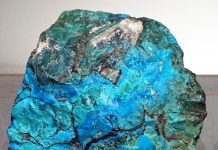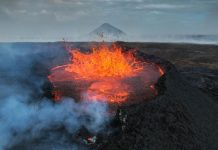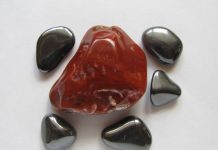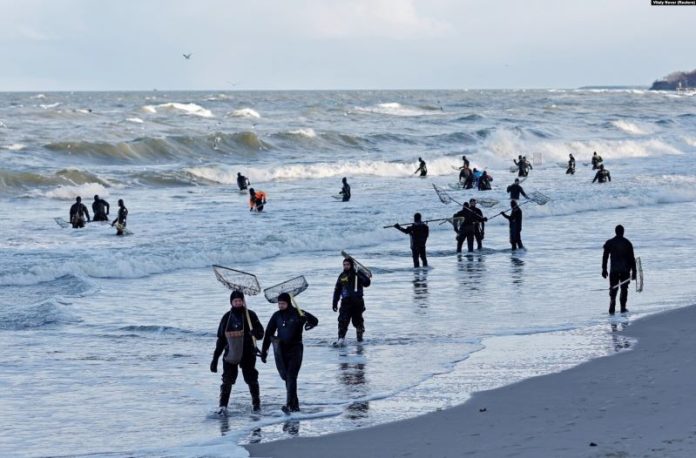
Minerals in beach sand have yielded tons of gold, millions of carats of diamonds, numerous fine specimens of nephrite jade, huge amounts of amber and much of the world’s titanium. Some beaches, however, are not known for their valuable metals and minerals, but for their unusual colors—white, black, green and even purple.
For many of us, the word “beach” evokes pleasant images of summers spent enjoying sun, sand and surf. But for geologists this word has a more specific meaning, referring to waterborne accumulations of sand that sometimes host economic concentrations of gemstones and other valuable minerals.
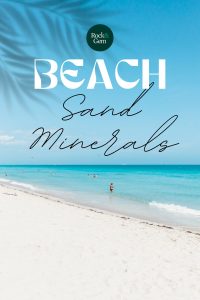
Nome’s Beach of Gold
While beaches today draw hordes of summer vacationers, in 1900 the Bering Sea beaches at Nome, Alaska, attracted more than 20,000 adventurers and miners in a wild search for placer gold minerals in beach sand.
Nome’s gold occurred along a narrow, 30-mile-long tidal beach where the traditional mining-claim system was largely ignored. The beaches were wide open to everyone and miners initially worked with gold pans, then sluices and rockers, later with pumps and hoses, and finally with dredges. Nome’s location, just 125 miles south of the Arctic Circle, limited mining to the brief summer season.
Dredge miners still recover gold at Nome today. Over its 123-year history, the Nome Mining District has produced 3.6 million troy ounces (111 metric tons) of gold, most of it from the beaches. The Nome gold rush is memorialized in the song North to Alaska and the 1960 John Wayne movie of the same name.
Namibia’s Diamond Beaches
Beachcombers sometimes whimsically imagine the water-polished bits of colorless quartz glittering in the shoreline gravels at their feet to be diamonds. But imagination is not necessary when finding minerals in beach sand in the southwest African nation of Namibia, where the sands are yielding millions of carats of diamonds.
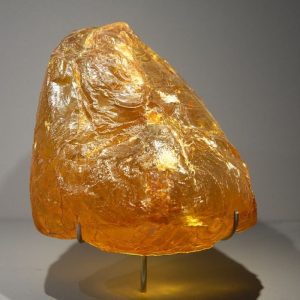
The Baltic’s Amber Beaches
The oldest known instance of systematic beach mining took place along the southern shore of the Baltic Sea some 16,000 years ago when Paleolithic beachcombers began collecting amber, a fossilized tree resin that had eroded free from sediments of the Baltic seafloor. Currents then swept this amber south to wash ashore on the beaches of what are now Poland, Lithuania and Kaliningrad, Russia.
During Roman times, Baltic amber was traded throughout Europe and North Africa. Today, it is the Baltic region’s iconic gem material. With amber now selling at record prices, recreational and commercial collectors continue to recover gem-quality material from the beaches. Baltic beach amber is a renewable resource and collecting is most productive following storms that regularly wash quantities of new gem material onto the beaches.
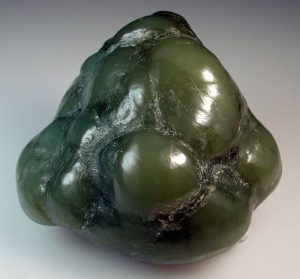
California’s Jade Beaches
The beaches near California’s coastal community of Big Sur are popular collecting sites for nephrite. One of the two types of jade, nephrite occurs in veins within metamorphic rock along the tectonic subduction zones of the central California coast. Exposed by beach erosion, these veins are the source of the jade found in the beach cobbles at Big Sur.
Most of Big Sur’s jade is forest-green in color and exhibits varying degrees of translucency. Beachcombers collect jade from the beach cobbles, while scuba divers search for it on the sea bottom. The rarest and most valuable specimens are those of botryoidal jade with its smooth, bubble-like surfaces.
The annual Big Sur Jade Festival attracts beachcombers, lapidaries and jade carvers from across the country. Would-be jade collectors must be aware that some beaches are off-limits and that collecting restrictions apply.
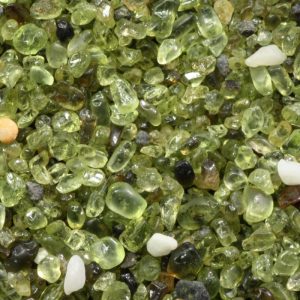
Titanium and the “Rainbow” Beaches
The minerals in beach sand in Australia and South Africa provide much of the world’s titanium, a space-age alloying metal and the source of “titanium white,” an opaque, white pigment widely used in such products as paints, plastics and processed foods. Both ilmenite (iron titanium oxide) and rutile (titanium oxide) occur in concentrated layers of heavy, dark particles within beach-sand deposits. More than 80 million tons of titaniferous beach sands are mass-mined each year to yield 800,000 tons of ilmenite-rutile concentrate.
Other beaches are notable for their unusual colors. White-sand beaches, most common in tropical climates, usually consist of grains of iron-free quartz, bleached coral, or aragonite (calcium carbonate) from shells. The coloring components of Hawaii’s well-known black-sand and green-sand beaches are, respectively, bits of dark basalt and peridot (magnesium silicate). And in Canada, the distinctive purple sands of several Saskatchewan and Manitoba lake beaches consist primarily of tiny grains of almandine-pyrope garnet.
Although beaches might not all offer valuable minerals, gemstones, or unusually colored sands, we can nevertheless always count on them for sun, sand and surf.
This story about minerals in beach sand previously appeared in Rock & Gem magazine. Click here to subscribe. Story by Steve Voynick.


